The Liability of Being Late

We’ve all been there. You accidentally snooze through your alarm, or some unexpected event sets your morning back a few paces. Before you know it, you’re in danger of being late for some upcoming appointment or, even worse, work.
So what are your options? Beyond coming up with a creative excuse to help explain your delay, you might consider putting the pedal to the metal to help make up ground (and time) once you’re finally out the door.
To understand how our driving habits change when we’re late, we surveyed 1,000 Americans about the speeds they’re willing to drive to avoid a tardy slip and the potentially hazardous road habits people develop when racing against the clock. Continue reading to see what we learned.
The Need for Speed
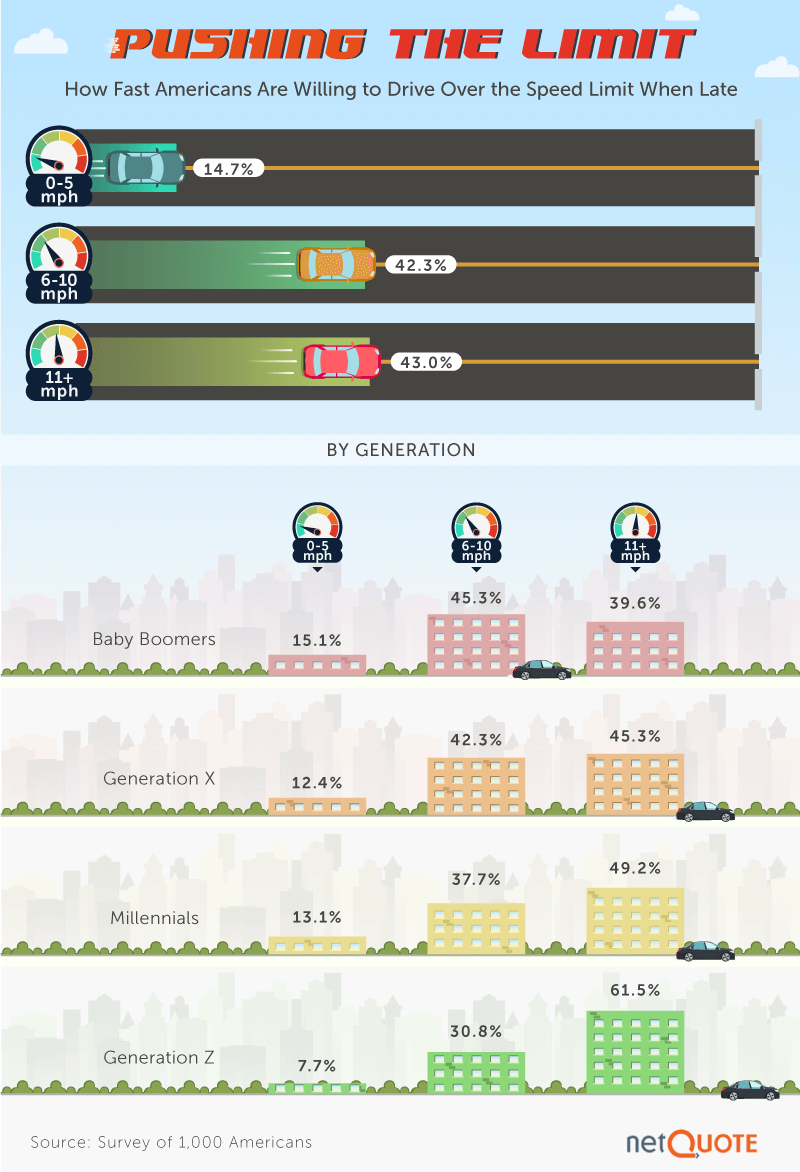
Virtually everyone surveyed was willing to go a little faster when they realized they were running behind. A minority (less than 15 percent) kept that excess speed to a maximum of 5 mph over the limit.
More than 42 percent of Americans were willing to drive between 6 and 10 mph faster than the legal limit. While popular opinion holds that driving up to 10 mph faster than the limit won’t earn you the unwanted attention of law enforcement, that myth simply isn’t true. Just because you may be less likely to get pulled over at these speeds doesn’t mean it can’t happen.
So which Americans were willing to drive the fastest when running late? Gen Zers. Over 61 percent of Gen Zers drove more than 11 mph over the limit when they were behind schedule. Almost 50 percent of millennials also drove 11 mph or over when running late, while baby boomers were the most restrained with their speeding habits.
Keeping Your Eyes on the Road
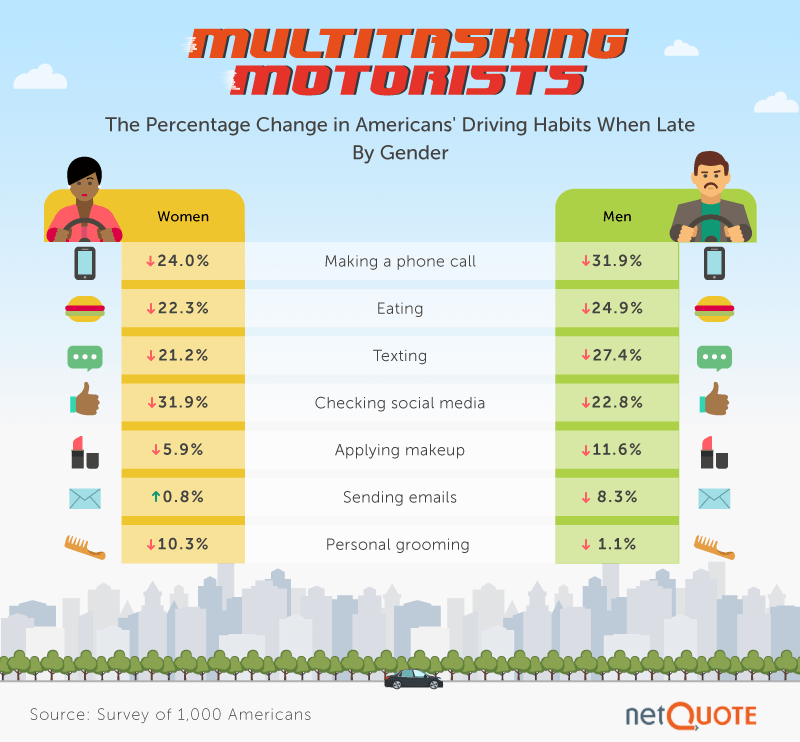
Our survey also found accelerated speeds weren’t the only changes in commuting habits when the clock was ticking.
There are plenty of things we do in the car aside from driving – and some of them can be very distracting when it comes to keeping our eyes (and focus) on the road. While studies have found that passively listening to the radio can improve driving performance, other activities (like those that involve electronics) can be downright dangerous.
While making phone calls and eating were the most common habits of men and women under normal driving circumstances, nearly 32 percent of men and 24 percent of women said they were less likely to talk on the phone when they were behind schedule. Additionally, almost 32 percent of women were less likely to check social media, and over 27 percent of men were less inclined to text.
Around 8 percent of men were less likely to send emails when late, yet a small percentage of women were actually more likely to compose an email.
Aggressive Driving Tendencies
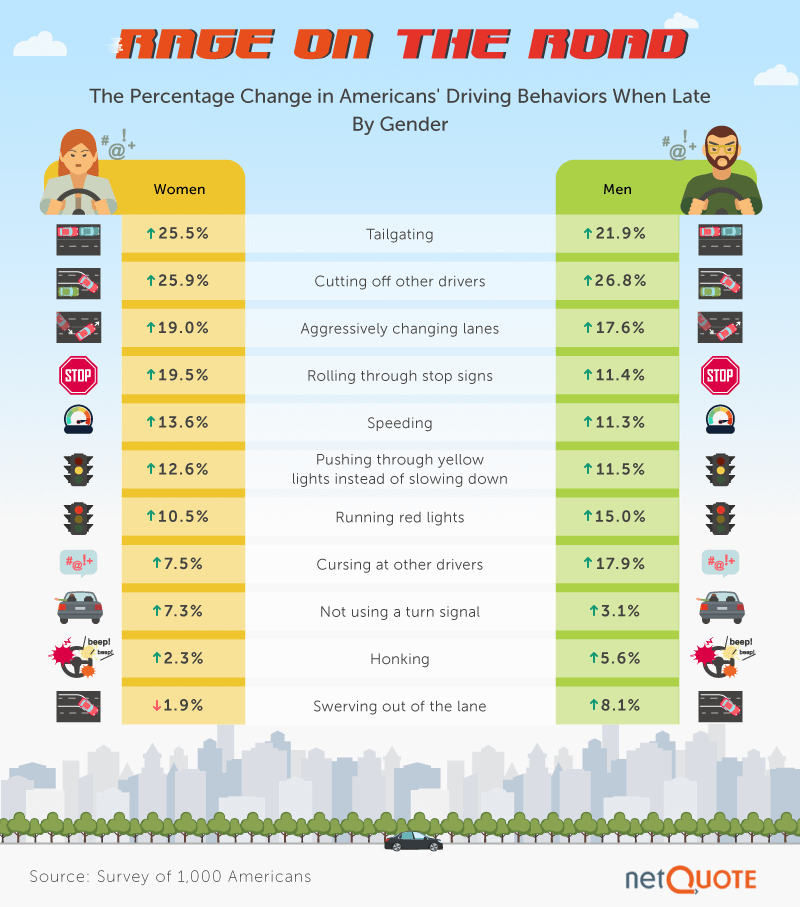
Running late can sometimes bring out the worst in our driving behavior.
Both men and women were over 11 percent more likely to push through a yellow light (instead of slowing down) when time was of the essence. According to the Insurance Institute for Highway Safety, 27 percent of crash fatalities in 2015 were the result of speeding-related accidents. Higher speeds are especially dangerous because they make it more difficult for drivers to slow down and increase the force of impact. Driving 15 mph or more over the speed limit will get you categorized as an aggressive driver, so take care to identify behaviors that may be harmful.
Speeding wasn’t the only road rage faux pas Americans admitted to when they were late and on the road. Men (nearly 27 percent) and women (almost 26 percent) were most likely to cut off other drivers when trying to get somewhere fast, while 19 percent of women and nearly 18 percent of men were more likely to aggressively change lanes when tardy. Depending on where you live, each of these actions may be just as likely to earn you a ticket as speeding. Just remember, before you tailgate or cut someone off, that over 91 percent of Americans find this incredibly annoying or even road rage-inducing.
Prioritizing Your Day
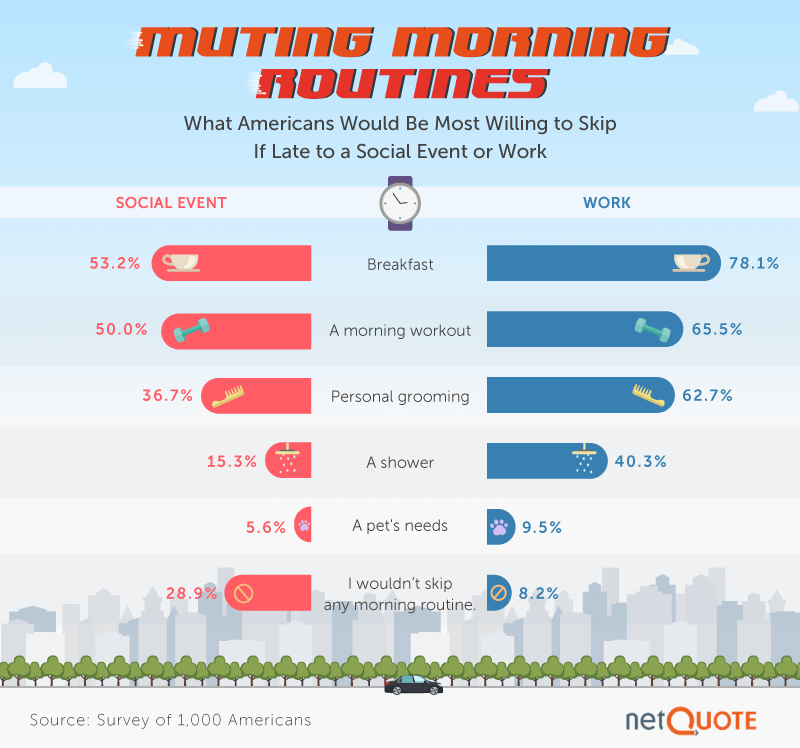
We’ve already established that Americans will do some risky things on the road when running late. But how much does a driver’s intended destination impact their rushing?
Over 78 percent of people said they would skip breakfast in the morning if it meant making it to work on time. Everyone knows breakfast is the most important meal of the day, but for the nearly 1 in 5 Americans who are late to work on a weekly basis, cutting out the mere minutes it may take to pour a bowl of cereal could be the difference between being on time and clocking in late. More than 65 percent of Americans would also cut out their morning workout when late to work, and about 63 percent would skip personal grooming if running behind schedule.
To the delight of bosses everywhere, Americans were more inclined to adjust their mornings for work than social events. While more than half would skip breakfast or morning workouts under more casual circumstances, nearly 29 percent of people wouldn’t change anything about their morning practices when in danger of being late to a social gathering compared to less than 9 percent of people at risk of being late to work.
Things to Do, People to See
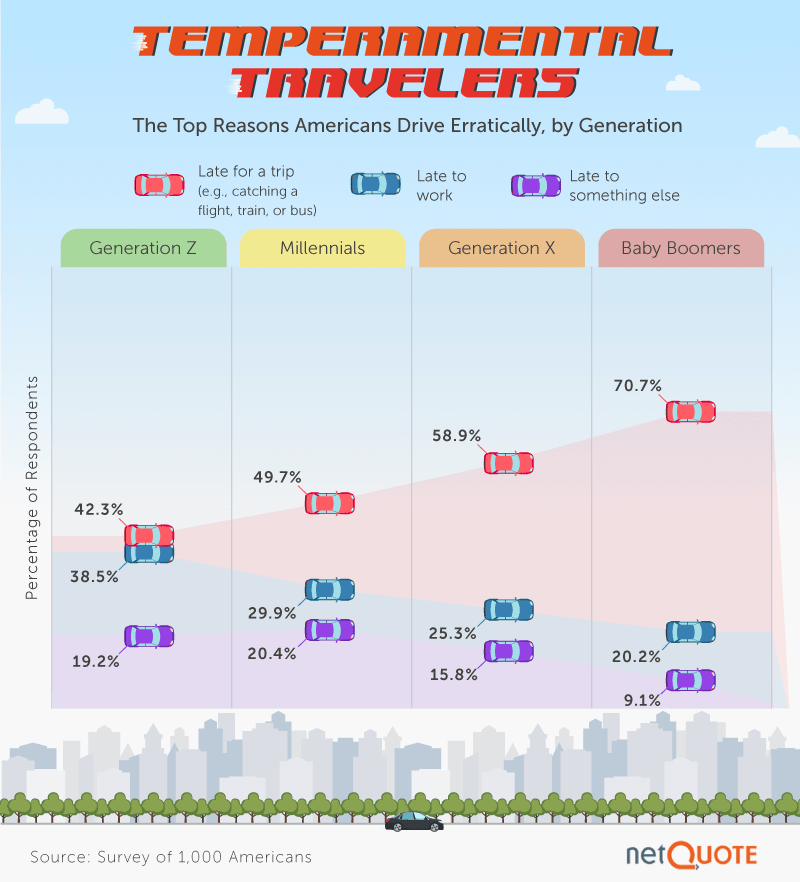
There’s no question being late to work is reason enough for some people to burn a little extra rubber – but if there’s one thing that’s even more likely to inspire Americans to break the laws of the road, it’s their vacations.
Research has shown that more than half of Americans aren’t taking all of their paid holiday time, but when they do go on trips, the fear of being late to catch that flight or train can be even more motivating than just about anything else. While about 30 percent of millennials erratically drive when they’re late to work, nearly half drive that way when late for a trip. Even baby boomers, the most conservative driving generation surveyed, were over three times as likely to drive erratically when a trip was on the line compared to when they were late to work.
Take It Easy
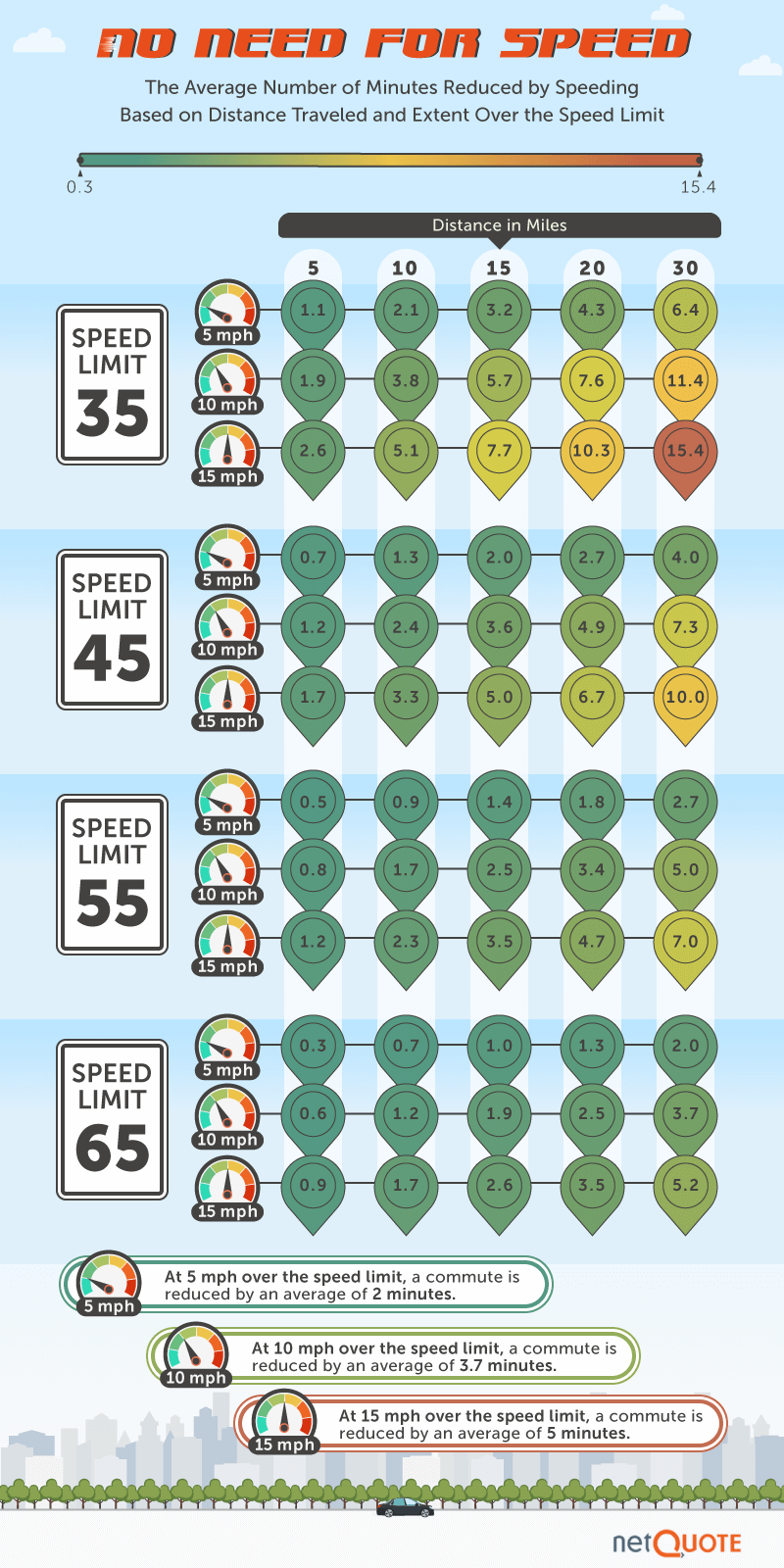
Speeding with the intention of saving time can be a dangerous idea. According to the Insurance Institute for Highway Safety, Highway Loss Data Institute, over 35,000 people died in motor vehicle crashes in 2015 – nearly 30 percent of these deaths were speeding-related.
Our table shows the mere minutes potentially salvaged by speeding. To cut even 15 minutes, which is the highest number of minutes “saved,” a driver would have to travel 15 mph over a posted speed limit of 35 mph, sustained over 30 miles. Commonly categorized as reckless driving, speeding 15 mph or more over the speed limit could have big consequences on your driving records in most states. On average, speeding can only reduce drive time by around five minutes, but the risk of a fatal car crash or hefty fine as possible consequences could prove much more impactful.
Speedy Regions
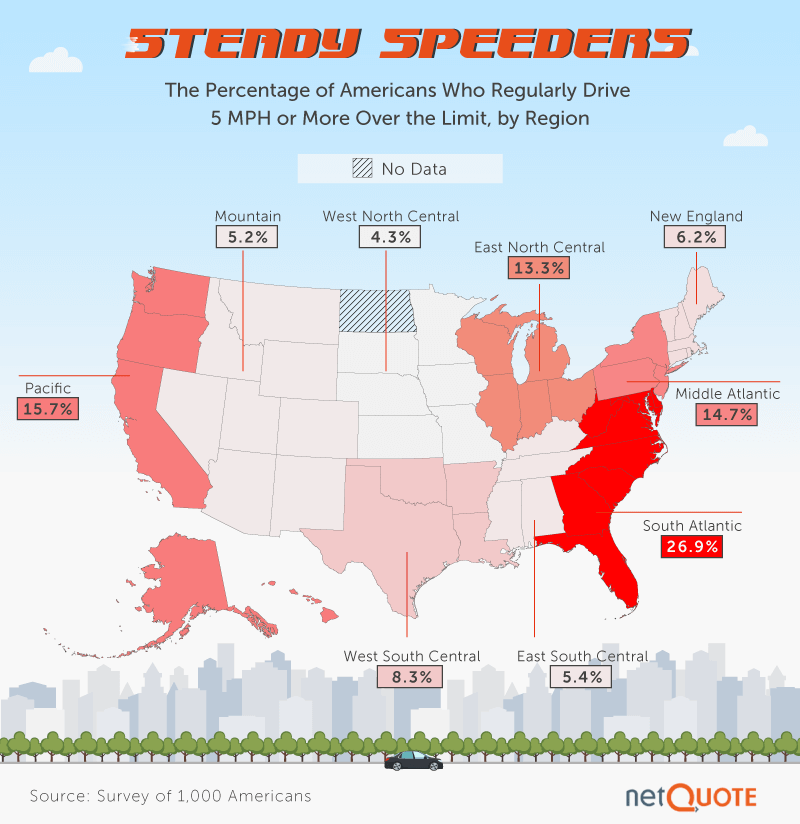
Whether driving 5, 10 or 15 mph over the speed limit, excessive speeds pose increased risks to drivers, passengers, and pedestrians on or near the road. Speeding alone caused over 9,500 speeding-related fatalities in 2015. Despite speeding fines and these grim statistics, respondents still admitted to speeding, sometimes at an excess of 15 mph over the posted limit. So which parts of the U.S. should you be the wariest of on the road?
According to our survey, almost 27 percent of habitual speeders lived in the South Atlantic region, which includes states such as Florida, Georgia, the Carolinas, and Washington, D.C. The West North Central region had the smallest percentage of speeders, with roughly 4.3 percent of drivers in this area admitting to cruising over the limit.
Misguided Motoring
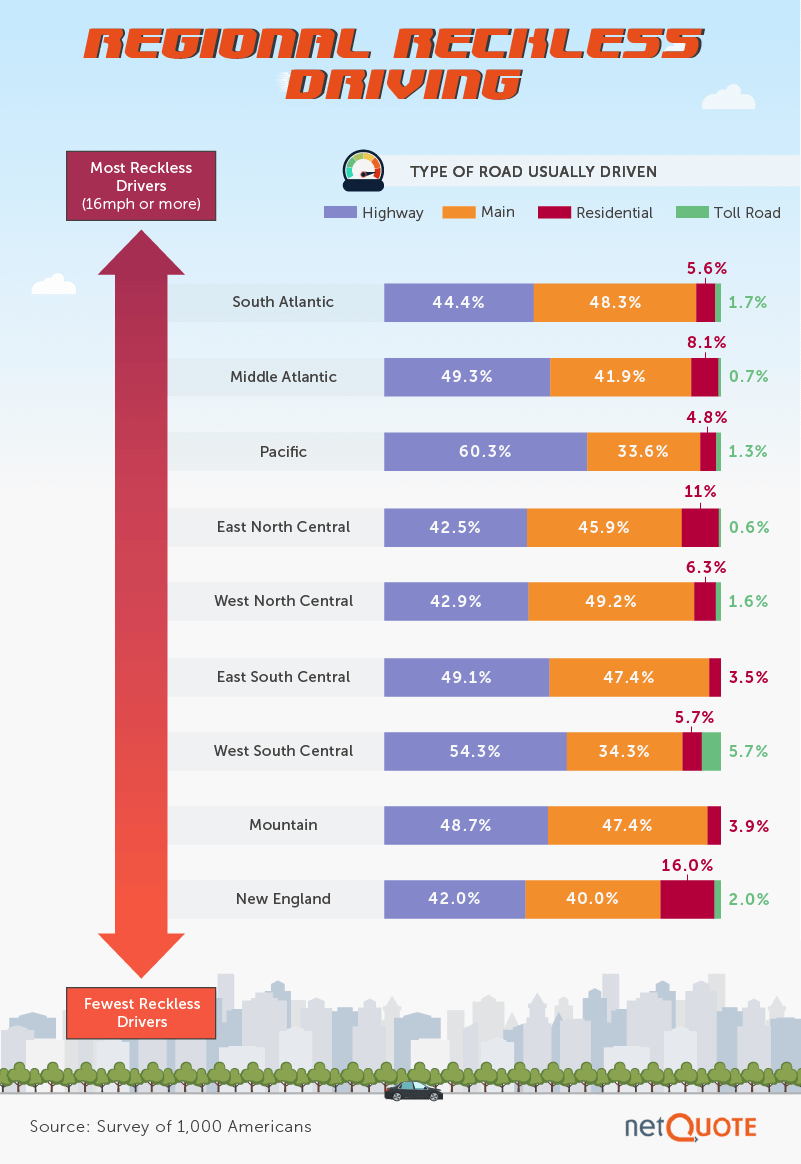
Depending on the state you live in, drive more than 15 mph over the speed limit and chances are you could be considered a reckless driver. In our study, we found drivers in the South Atlantic not only sped the most frequently, but they also drove the furthest over the speed limit, with 1.4 percent of speeders driving 16 mph or more over the limit. Their roads of choice? Nearly half of respondents cited main roads or highways as their prime choices for traveling. So be wary of reckless drivers when driving on roads like U.S. Route 1 or Interstate 95 if you’re driving through the South Atlantic.
Safety First
Regardless of how real (or not) your excuses are for being late – or if being tardy really does indicate a higher level of creativity – driving when late can lead to dangerous roadway habits. Americans did everything from cursing at other drivers to speeding and running red lights.
Although getting to work on time is important, so are your safety and the safety of others on the road. It’s better to arrive safe than sorry.
METHODOLOGY
We surveyed 1,000 Americans on their driving behaviors, including when they are on time or running late. We asked which driving behaviors they engaged in less or more often when running late as well as basic demographic questions. We calculated how much time it would take to travel distances between 5 and 30 miles at different speed limits. Then, we calculated how long it would take to travel those same distances at 5, 10 and 15 miles per hour over posted speed limits, and built the table using the difference between posted speed limit times and speeding times.
Fair Use Statement
Would you like to share our findings on speeding habits with friends and family? We invite you to share our study for noncommercial purposes only. When sharing or posting, please link back to this page to give us credit for our work!
